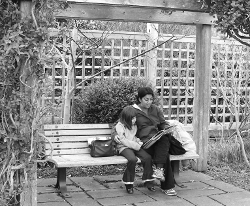Victoria – Bench by Bench
A Creative Guide to over 60 Intriguing Sites
Introduction
A woman sits on a bench in the rose garden, a book open on her lap. Her daughter, feet dangling, snuggles next to her. They come here to be together. To read. No distractions. Just them, the bench, the birds, the flowers. Stopping together. Outside.

Some guidebooks encourage you to keep going. This book is to encourage you to stop.
I started my search for benches when I first came to Victoria. Sometimes I would wander, turning left or right on a whim. Sometimes I would pore over a map, looking for the little green, shaded areas that represent parks. I searched for two reasons. One was to discover this place that I had moved to—the landscape, the history, the buildings, the people. The other was to re-create myself. Who was I now that no one knew me? When people would ask me, “What do you do?” I had to have an answer. “I walk around. I stop. I look. I listen.”
I searched out places to write. I would walk until a bench caught my eye, then sit and write what I saw around me. Write whatever came out, squiggly lines on a page. Some might call it creative writing.
This book is about creativity. Giving you permission to take some time for yourself, to feel your feet on the ground. To really see the world around you, and in seeing the world, open that door to allow your creative expression to come out.
This is about discovery. To discover something that you didn’t know or understand before, to see something spectacular. How will you see the bridge open for that special boat if you don’t sit here? The sea lion lifting its head to sniff the air. The flower turning to face the sun. The beauty in the bark of that gnarly tree. The dead grasses, buffeted by the wind. The sea gulls, hovering and diving, flying for the fun of it.
This is what I want to capture, inspiring you to experience the simple things around you, and through this experience, to open up a little, to let a sense of calm and playfulness come in.
While working on this book I set off to document that perfect bench, a place sheltered from the wind, or with a great view. But I don’t have time to pause long, just long enough to capture the essence of the place. I have to keep going to the next bench.
I am caught, rushing about. I sit. I breathe. I force myself to become still. It works sometimes. Trying to find that elusive balance between my to-do list and my attempt at stillness. How can I stay in a creative groove, in touch with my core, and still get everything done?
Our culture has taught us busyness. We love our to-do lists and our efficiency and productivity. We brag about how busy we are. And then we schedule in the spa time and the weekend workshops that promise relaxation. We dream of retirement, but we never really learn how to stop, to become still.
I am caught in my own schedule, my own reluctance to actually stop. How am I supposed to write a book about sitting when I can’t even do it myself? Just sitting. No wonder no one does it. It’s too complicated. It is too much work to just sit. And breathe. And see. And feel. Without incessant activity, the space around us opens up. And panic sets in. I should be doing something.
But I stay a little longer. I get used to it. Sitting. Outside. No other distractions. No laundry to fold or dishes to wash.
Come to a bench with a friend to sit together. Come alone. I invite you to go exploring, check out the benches in this book, and find your own favourite places. Take the time to stop and look at the world through fresh eyes. Create some time for yourself to just sit.
